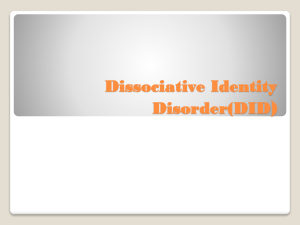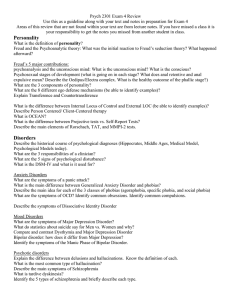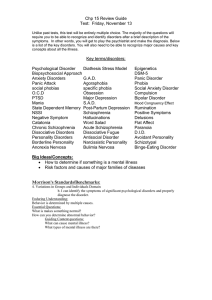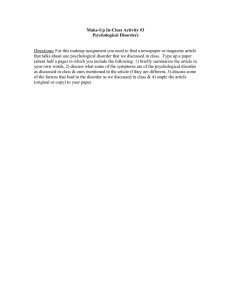CHAPTER 13 PSYCHOLOGICAL DISORDERS (Student Version).doc
advertisement
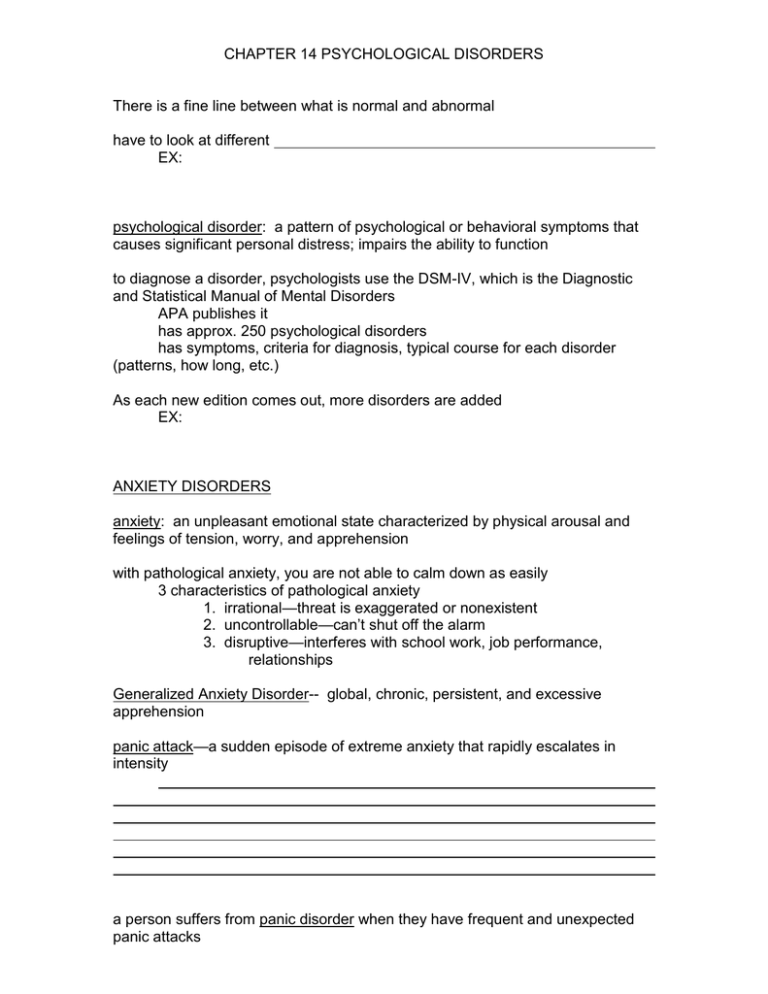
CHAPTER 14 PSYCHOLOGICAL DISORDERS There is a fine line between what is normal and abnormal have to look at different EX: psychological disorder: a pattern of psychological or behavioral symptoms that causes significant personal distress; impairs the ability to function to diagnose a disorder, psychologists use the DSM-IV, which is the Diagnostic and Statistical Manual of Mental Disorders APA publishes it has approx. 250 psychological disorders has symptoms, criteria for diagnosis, typical course for each disorder (patterns, how long, etc.) As each new edition comes out, more disorders are added EX: ANXIETY DISORDERS anxiety: an unpleasant emotional state characterized by physical arousal and feelings of tension, worry, and apprehension with pathological anxiety, you are not able to calm down as easily 3 characteristics of pathological anxiety 1. irrational—threat is exaggerated or nonexistent 2. uncontrollable—can’t shut off the alarm 3. disruptive—interferes with school work, job performance, relationships Generalized Anxiety Disorder-- global, chronic, persistent, and excessive apprehension panic attack—a sudden episode of extreme anxiety that rapidly escalates in intensity a person suffers from panic disorder when they have frequent and unexpected panic attacks PHOBIAS phobia: an intense and irrational fear of a particular object or situation of the population have a phobia that disrupts their daily functioning women are as likely as men to suffer from a severe phobia when a person suffers from a specific phobia, they are terrified of a specific object or situation 4 categories of specific phobias 1) 2) 3) 4) the most common phobia that people seek treatment for is agoraphobia: fear of having a panic attack in public and not being able to escape or get help social phobia: fear of social situations, especially performing a task in front of other people EX: OBSESSIVE-COMPULSIVE DISORDER a person’s life is dominated by repetitive thoughts and behaviors obsession—person has repeated, intrusive, and uncontrollable thoughts or mental images; causes the person to be anxious and distressed EX: compulsion: the person does repetitive behaviors to relieve the anxiety from obsessions EX: Most common: MOOD DISORDERS mood disorder: a serious, persistent disturbance in a person’s emotions that cause psychological discomfort, and/or impairs the ability to function the most common mood disorder is major depression, it’s called the common cold of mental disorders 4 categories 1. 2. 3. 4. to be diagnosed with major depression, have to have symptoms for 2 weeks or more there are approximately Americans suffering from major depression women more likely than men (women- 1:4; men- 1:8) those at higher risk are b/t ages 15-24 and 35-44 runs in families, esp. if mother suffered from depression, women more likely to suffer from it then (3xs more likely) risk factors: treatment is usually in the form of antidepressants; the more common ones are SSRIs (selective serotonin reuptake inhibitors), which increases the amount of serotonin in the body another treatment for severe depression, or when the patient is suicidal, is electroconvulsive therapy, or shock therapy where an electrical current is sent through the brain, creating a seizure the patient is usually disoriented for a few hours after; main side effect is memory loss bipolar disorder: was called manic depression; major depression with the person experiencing extreme euphoria and excitement manic episode: diagnosed usually in the early 20s approx. 2 mil Americans have bipolar disorder (1% of men and women) medication used is lithium, because of severe depressive episodes (bipolar patients tend to have low levels of serotonin) and also for the mania (balances the levels of another neurotransmitter called glutamate) PERSONALITY DISORDERS personality disorder: person has inflexible and maladaptive thoughts, behaviors, emotions that are consistent over time and are not representative of the person’s culture 3 most common personality disorders 1. paranoid personality disorder: characterized by mistrust and suspiciousness of others, always thinks others are trying to harm them in some way 3% of population; more men than women not much research on causes 2. borderline personality disorder: most commonly diagnosed personality disorder; person’s emotions, relationships, and self-image are unstable; have extreme mood swings are self-destructive (self-mutilate, have suicidal thoughts and attempts) 10 million Americans, 2/3 of them women possible causes- disrupted attachment in early childhood and sexual, emotional, or physical abuse during childhood 3. antisocial personality disorder: person has a blatant disregard when violating the rights of others; most commonly called psychopaths or sociopaths usually diagnosed in late childhood or early adolescence EX: occurs in 6% of men and 1% of women DISSOCIATIVE DISORDERS dissociative experience: awareness, memory, and identity are disrupted EX: a dissociative experience can become a dissociative disorder when the experience is more extreme, frequent, and disrupts daily functioning 3 basic dissociative disorders 1. dissociative amnesia where the person remembers little or no personal information 2. dissociative fugue where the person is unsure of his own identity 3. dissociative identity disorder: formerly known as multiple personality disorder memory is extensively disrupted, there is a presence of 2 or more distinct identities (called alters); the most common amount of alters is 10 to 15 characteristics of alters: 1. 2. 3. 4. 5. EX: always have memory problems or amnesia they “lose time” from their childhood usually caused by extreme physical or sexual abuse in childhood SCHIZOPHRENIA schizophrenia: thought processes, beliefs, and perceptions are severely distorted; lose touch with reality the most serious psychological disorder affects 1 out of 100 people; begins in adolescence or early adulthood positive—the abnormal behaviors that occur in schizophrenics EX: hallucinations: imaginary sensations, most common are auditory, hearing voices delusions—false beliefs that others don’t share 1. delusions of grandeur-- believe they are a famous person with great knowledge, ability, or authority EX: 2. delusions of persecution-- falsely believe that some person or agency is trying to get them in some kind of way EX: negative-- decrease in thoughts and behaviors EX: may have flat affect—no emotions at all; look like a robot those schizo with neg symptoms seem to have the poorest outcomes 3 types of schizophrenia 1. catatonic schizo can be completely still or highly agitated can “freeze” with a bizarred look on their faces or in a bizarre posture 2. disorganized schizo most serious type have extreme social withdrawal, hallucinations, delusions, laughter, grimaces, bizarre behavior may show flat or inappropriate affect many times are incoherent obscene behavior have poorer chance of recovery 3. paranoid schizo delusions of grandeur or persecution exaggerated anger and suspicion can get violent to protect themselves if they think someone is trying to hurt them chance for recovery is better than in catatonic or disorganized CAUSES OF SCHIZO Evidence shows that it may be more biological GENETICS Tends to run in families if 1 parent has it, 13:100 chance of developing 2 parents, 46:100 chance adopted children are 10xs more likely to develop if one of parents has than if adopted parent has it

